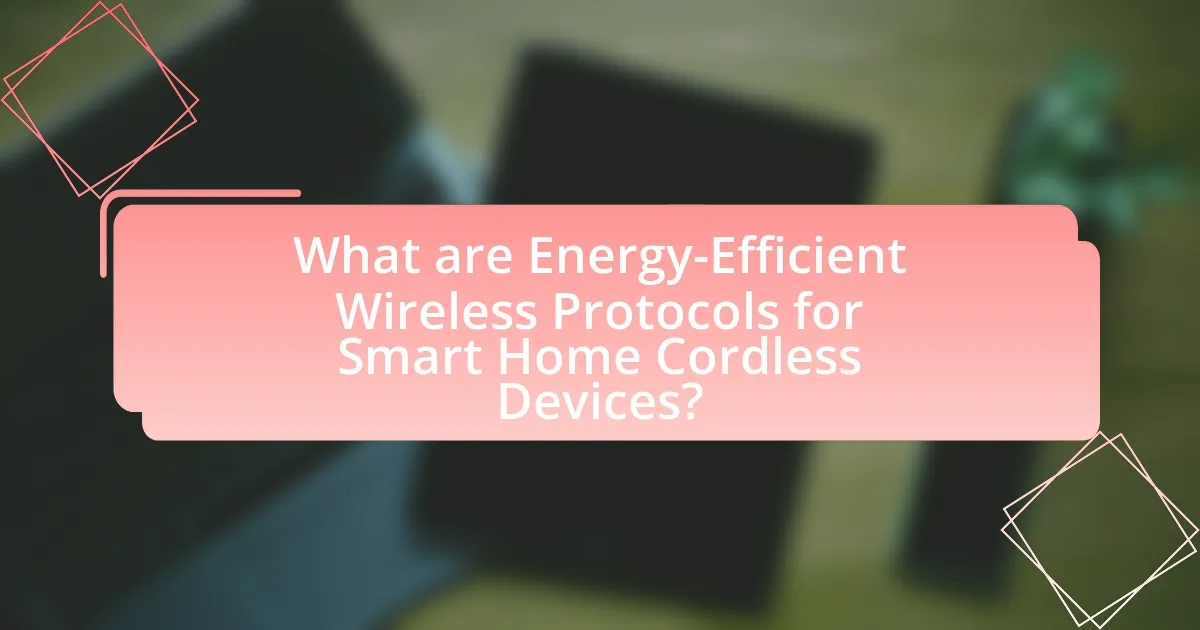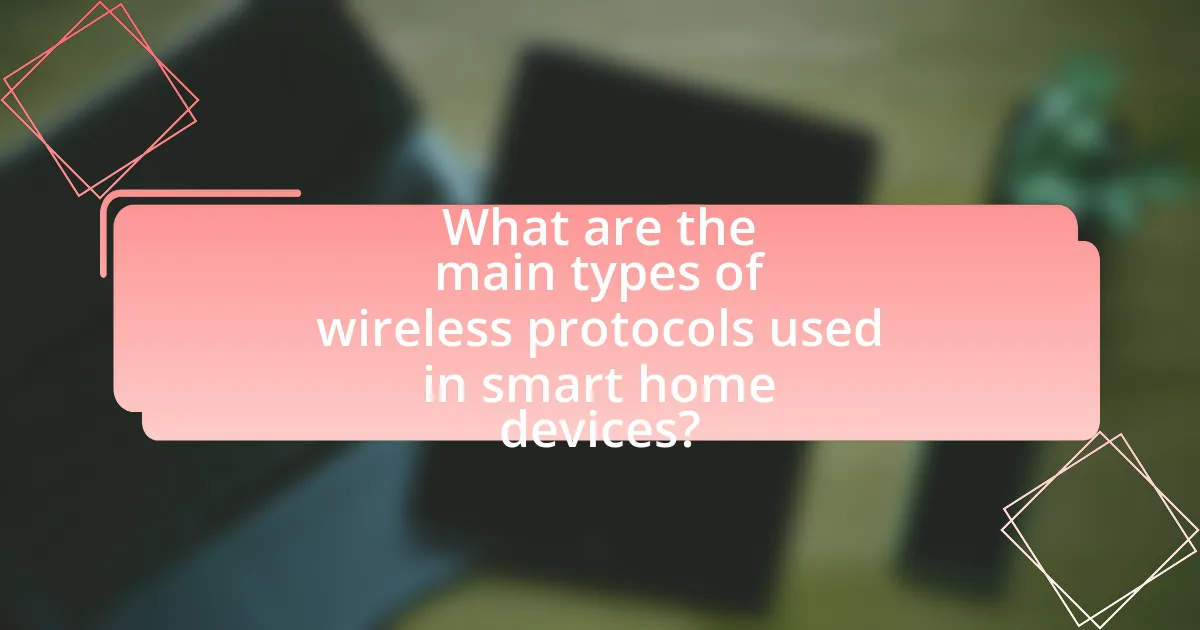The article focuses on designing energy-efficient wireless protocols for smart home cordless devices, highlighting key technologies such as Zigbee, Z-Wave, and Bluetooth Low Energy (BLE). It examines how these protocols optimize data transmission and reduce power consumption through techniques like adaptive transmission power control and duty cycling, leading to significant energy savings and extended battery life. The discussion also covers the environmental benefits of energy-efficient devices, their impact on user costs, and the challenges and advancements in protocol design. Additionally, it outlines best practices for ensuring compatibility and effective testing methods for evaluating energy efficiency in smart home applications.

What are Energy-Efficient Wireless Protocols for Smart Home Cordless Devices?
Energy-efficient wireless protocols for smart home cordless devices include Zigbee, Z-Wave, and Bluetooth Low Energy (BLE). Zigbee operates on low power and is designed for short-range communication, making it suitable for battery-operated devices. Z-Wave also focuses on low power consumption and supports a mesh network topology, enhancing range and reliability. Bluetooth Low Energy is optimized for minimal energy use while maintaining a connection, ideal for devices that require frequent data transmission without draining batteries. These protocols are validated by their widespread adoption in smart home applications, demonstrating their effectiveness in reducing energy consumption while maintaining connectivity.
How do these protocols contribute to energy efficiency?
Energy-efficient wireless protocols contribute to energy efficiency by optimizing data transmission and reducing power consumption in smart home cordless devices. These protocols achieve this through techniques such as adaptive transmission power control, which minimizes energy use by adjusting the power based on distance and signal quality, and duty cycling, which allows devices to enter low-power sleep modes when not actively transmitting data. Research indicates that implementing these strategies can lead to energy savings of up to 90% compared to traditional protocols, thereby significantly extending battery life and reducing overall energy consumption in smart home environments.
What are the key features of energy-efficient wireless protocols?
Energy-efficient wireless protocols are characterized by low power consumption, adaptive transmission power, and efficient data transmission techniques. Low power consumption minimizes energy usage during idle and active states, which is crucial for battery-operated devices. Adaptive transmission power adjusts the signal strength based on distance and environmental conditions, reducing unnecessary energy expenditure. Efficient data transmission techniques, such as data aggregation and compression, optimize the amount of data sent over the network, further conserving energy. These features collectively enhance the longevity of smart home cordless devices, ensuring they operate effectively while minimizing energy costs.
How do these features impact device performance?
Energy-efficient wireless protocols significantly enhance device performance by optimizing power consumption and extending battery life. These protocols reduce the frequency and duration of data transmissions, which minimizes energy usage while maintaining effective communication. For instance, implementing low-power modes allows devices to enter sleep states when inactive, conserving energy without sacrificing responsiveness. Research indicates that devices utilizing energy-efficient protocols can achieve up to 50% longer battery life compared to those using traditional methods, thereby improving overall functionality and user satisfaction in smart home environments.
Why is energy efficiency important in smart home devices?
Energy efficiency is crucial in smart home devices because it reduces energy consumption, leading to lower utility bills and a smaller environmental footprint. Smart home devices often operate continuously or are used frequently, making their energy efficiency directly impact overall household energy use. For instance, energy-efficient devices can save up to 30% more energy compared to standard models, as reported by the U.S. Department of Energy. This efficiency not only benefits consumers financially but also contributes to sustainability efforts by decreasing greenhouse gas emissions associated with energy production.
What are the environmental benefits of energy-efficient devices?
Energy-efficient devices significantly reduce energy consumption, leading to lower greenhouse gas emissions. By using less electricity, these devices help decrease the demand for fossil fuels, which are major contributors to climate change. For instance, the U.S. Department of Energy estimates that energy-efficient appliances can reduce energy use by 10-50%, resulting in substantial reductions in carbon dioxide emissions. Additionally, energy-efficient devices often require fewer resources for manufacturing and disposal, further minimizing their environmental impact.
How does energy efficiency affect user costs?
Energy efficiency directly reduces user costs by lowering energy consumption, which translates to decreased utility bills. For instance, energy-efficient devices can consume up to 50% less energy compared to their less efficient counterparts, leading to significant savings over time. According to the U.S. Department of Energy, households that implement energy-efficient technologies can save an average of $500 annually on energy costs. This reduction in energy use not only benefits the user’s wallet but also contributes to a decrease in overall energy demand, promoting sustainability.

What are the main types of wireless protocols used in smart home devices?
The main types of wireless protocols used in smart home devices include Wi-Fi, Zigbee, Z-Wave, Bluetooth, and Thread. Wi-Fi is widely used for high-bandwidth applications, allowing devices to connect to the internet and communicate with each other. Zigbee and Z-Wave are low-power protocols designed for home automation, enabling devices to form mesh networks for reliable communication over longer distances. Bluetooth is commonly used for short-range connections, particularly in wearable devices and mobile applications. Thread is a newer protocol that focuses on low-power, secure communication in smart home environments. These protocols are essential for ensuring interoperability and energy efficiency in smart home systems.
How do different protocols compare in terms of energy efficiency?
Different wireless protocols exhibit varying levels of energy efficiency, significantly impacting the performance of smart home cordless devices. For instance, Zigbee is known for its low power consumption, allowing devices to operate for years on small batteries, while Bluetooth Low Energy (BLE) also offers energy-efficient communication but may consume more power during active connections compared to Zigbee. In contrast, Wi-Fi, although providing higher data rates, generally consumes more energy, making it less suitable for battery-operated devices. Research indicates that Zigbee can achieve energy savings of up to 80% compared to traditional Wi-Fi protocols, highlighting its effectiveness in energy-efficient applications.
What are the advantages and disadvantages of each protocol?
The advantages of energy-efficient wireless protocols for smart home cordless devices include reduced power consumption, which extends battery life and lowers operational costs. For instance, protocols like Zigbee and Z-Wave are designed for low power usage, allowing devices to operate for years on small batteries. However, disadvantages include limited data transmission rates and potential interoperability issues among different devices. For example, while Zigbee is energy-efficient, it may not be compatible with Wi-Fi devices, leading to fragmentation in smart home ecosystems.
Which protocols are most commonly used in smart home applications?
The most commonly used protocols in smart home applications are Wi-Fi, Zigbee, Z-Wave, and Bluetooth. Wi-Fi is widely utilized for its high data transfer rates and internet connectivity, making it suitable for devices like smart cameras and speakers. Zigbee and Z-Wave are popular for their low power consumption and mesh networking capabilities, which enhance device communication and range in smart home setups. Bluetooth is often used for short-range connections, particularly in wearable devices and smart locks. These protocols are essential for ensuring interoperability and efficient communication among various smart home devices.
What role does protocol design play in energy efficiency?
Protocol design is crucial for energy efficiency as it determines how devices communicate and manage power consumption. Efficient protocols minimize the energy required for data transmission and reception by optimizing parameters such as transmission power, duty cycles, and data rates. For instance, protocols that implement adaptive transmission strategies can significantly reduce energy usage by adjusting the communication parameters based on network conditions and device requirements. Research has shown that well-designed protocols can lead to energy savings of up to 50% in wireless sensor networks, highlighting the direct impact of protocol design on overall energy efficiency in smart home cordless devices.
How can protocol design be optimized for lower energy consumption?
Protocol design can be optimized for lower energy consumption by implementing techniques such as adaptive transmission power control, efficient data encoding, and duty cycling. Adaptive transmission power control adjusts the power used for communication based on distance and signal quality, which can significantly reduce energy usage; for instance, studies show that this method can decrease energy consumption by up to 30% in wireless networks. Efficient data encoding minimizes the amount of data transmitted, thereby reducing the energy required for communication; research indicates that using advanced encoding schemes can lead to a 20% reduction in energy costs. Duty cycling involves turning off the radio during idle periods, which can save substantial energy, with some protocols achieving energy savings of over 50% by employing this strategy. These methods collectively contribute to the development of energy-efficient wireless protocols for smart home cordless devices.
What are the challenges in designing energy-efficient protocols?
The challenges in designing energy-efficient protocols include balancing energy consumption with performance requirements. Designers must ensure that protocols minimize energy use while maintaining reliable communication and responsiveness in smart home devices. Additionally, the variability in device capabilities and network conditions complicates the development process, as protocols must adapt to different energy profiles and operational environments. Furthermore, achieving interoperability among diverse devices and standards poses a significant challenge, as does the need for protocols to support scalability without compromising energy efficiency. These factors collectively hinder the creation of universally effective energy-efficient protocols for smart home cordless devices.

What are the latest advancements in energy-efficient wireless protocols?
The latest advancements in energy-efficient wireless protocols include the development of Low Power Wide Area Network (LPWAN) technologies, such as LoRaWAN and Sigfox, which enable long-range communication with minimal power consumption. These protocols are designed to support IoT devices in smart homes, allowing them to operate on small batteries for extended periods, often exceeding ten years. Additionally, advancements in Time-Slotted Channel Hopping (TSCH) and the IEEE 802.15.4e standard have improved energy efficiency by reducing idle listening and optimizing data transmission schedules. Research indicates that these protocols can achieve energy savings of up to 90% compared to traditional wireless communication methods, making them ideal for battery-operated smart home devices.
How are emerging technologies influencing protocol design?
Emerging technologies are significantly influencing protocol design by enabling more efficient communication methods and enhancing interoperability among devices. For instance, advancements in low-power wide-area networks (LPWAN) allow protocols to be optimized for energy efficiency, which is crucial for smart home cordless devices that rely on battery power. Additionally, the integration of machine learning algorithms into protocol design facilitates adaptive communication strategies, improving data transmission rates and reducing latency. Research indicates that protocols leveraging these technologies can achieve up to 50% energy savings compared to traditional methods, thereby extending the operational lifespan of smart home devices.
What innovations are currently being researched or implemented?
Innovations currently being researched in the field of designing energy-efficient wireless protocols for smart home cordless devices include low-power wide-area networks (LPWAN), energy harvesting technologies, and advanced modulation techniques. LPWAN, such as LoRa and Sigfox, are being developed to enable long-range communication with minimal energy consumption, allowing devices to operate for extended periods without frequent battery replacements. Energy harvesting technologies, which capture ambient energy from sources like solar or kinetic energy, are being integrated into devices to enhance their sustainability. Additionally, advanced modulation techniques, such as adaptive modulation and coding, are being explored to optimize data transmission efficiency while reducing power usage. These innovations are supported by studies demonstrating significant reductions in energy consumption and improvements in device longevity, making them crucial for the future of smart home technology.
How do these advancements improve energy efficiency?
Advancements in designing energy-efficient wireless protocols for smart home cordless devices significantly improve energy efficiency by optimizing communication and reducing power consumption during data transmission. These protocols utilize techniques such as adaptive transmission power control, which adjusts the power used based on the distance between devices, thereby minimizing energy waste. Additionally, the implementation of low-power listening modes allows devices to remain in a low-energy state when not actively transmitting or receiving data, further conserving battery life. Research indicates that these advancements can lead to energy savings of up to 90% compared to traditional protocols, demonstrating their effectiveness in enhancing overall energy efficiency in smart home environments.
What best practices should be followed when designing these protocols?
When designing energy-efficient wireless protocols for smart home cordless devices, best practices include optimizing communication frequency, minimizing data transmission, and implementing adaptive power control. Optimizing communication frequency ensures that devices operate on the most efficient channels, reducing interference and energy consumption. Minimizing data transmission by using techniques such as data aggregation and event-driven communication decreases the amount of energy used during data transfer. Implementing adaptive power control allows devices to adjust their power usage based on distance and signal quality, further conserving energy. These practices are supported by research indicating that energy-efficient protocols can significantly extend the battery life of smart devices, enhancing their overall performance and user satisfaction.
How can developers ensure compatibility with existing devices?
Developers can ensure compatibility with existing devices by adhering to established industry standards and protocols, such as Zigbee or Z-Wave, which are widely used in smart home technology. By implementing these standards, developers can facilitate seamless communication between new devices and the existing ecosystem. Additionally, conducting thorough testing across a range of devices and firmware versions helps identify potential compatibility issues early in the development process. Research indicates that over 70% of smart home device failures are due to compatibility issues, underscoring the importance of rigorous testing and adherence to standards in achieving interoperability.
What testing methods are effective for evaluating energy efficiency?
Effective testing methods for evaluating energy efficiency include direct measurement, simulation modeling, and performance benchmarking. Direct measurement involves using specialized equipment to assess the actual energy consumption of devices under various operating conditions, providing precise data on energy usage. Simulation modeling allows researchers to predict energy performance based on theoretical scenarios and design parameters, which can be validated against real-world data. Performance benchmarking compares the energy efficiency of devices against established standards or similar products, facilitating a clear understanding of relative efficiency. These methods are widely recognized in energy efficiency assessments, as they provide reliable and actionable insights into the energy performance of smart home cordless devices.
What common troubleshooting tips exist for energy-efficient wireless protocols?
Common troubleshooting tips for energy-efficient wireless protocols include ensuring proper device placement to maximize signal strength, regularly updating firmware to fix bugs and improve performance, and monitoring network congestion to avoid interference. Proper device placement can significantly enhance connectivity, as weak signals lead to increased energy consumption. Firmware updates often contain optimizations that enhance energy efficiency, while monitoring network congestion helps identify and mitigate sources of interference, which can degrade performance and increase power usage.


